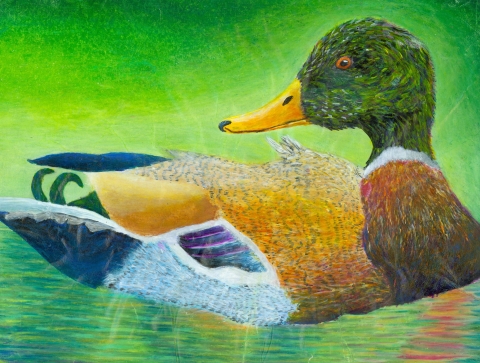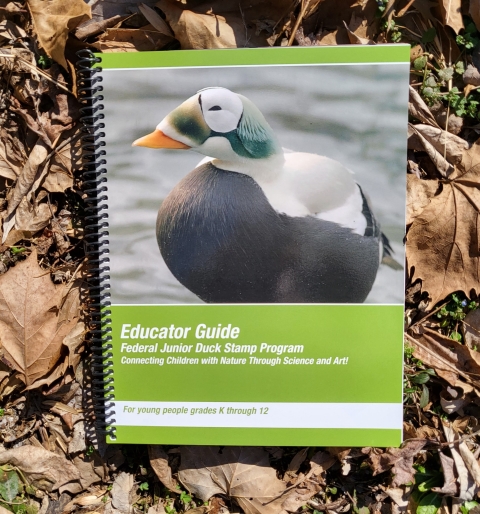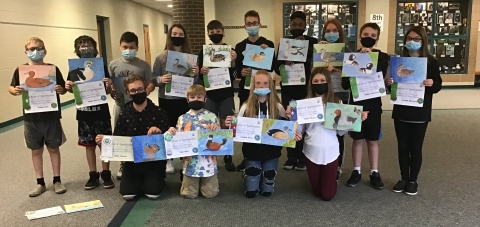The Indiana Junior Duck Stamp Program
The Junior Duck Stamp program connects children with nature through science and art! The dynamic and fun curriculum teaches students in grades K-12 about waterfowl and wetlands conservation through a simple, easy to enter, contest.
Why a Duck Stamp?
Since 1934 Federal Duck Stamps have been buying wetlands for wildlife. The collectible stamp, issued each year, is required of all waterfowl hunters, and was first established by President Roosevelt as a source of funding for national wildlife refuges and waterfowl conservation areas. The art contest to create each year's federal stamp design is a highly competitive event that attracts top wildlife artists from across the country.
The Junior Duck Stamp program is a student version of the federal duck stamp contest and is designed to promote learning about waterfowl and wetlands through art. Students in grades K-12 (or home school students) draw a picture of a native duck, goose, or swan and send it in to their State receiving site. The state winners are sent to the national contest, and the national contest winner is made into a Junior Duck Stamp which is sold as a collectible item which funds environmental education programs.
Contest Requirements
The basic requirements for the Junior Duck Stamp contest are for students to make an original, 9" x 12" drawing of a native species of duck, goose, or swan in an appropriate habitat. Indiana students must submit their work to the Muscatatuck National Wildlife Refuge by March 15 to be considered for the contest. No writing of any kind may appear on the front of the drawing and borders are not permitted. An official entry form must be attached to the back of the drawing. Only one entry can be made per student and the work must be done entirely by the student entering the contest. The Spanish entry form can be found here.
Allowed Species
World-wide there are many beautiful species of waterfowl but only waterfowl native to North American can be drawn for the Junior Duck Stamp contest. Species that may be drawn are: Fulvous whistling duck, Black-bellied whistling-duck, Trumpeter swan, Tundra swan, Greater white-fronted goose, Snow goose, Ross's goose, Emperor goose, Canada goose, Brant, Wood duck, American wigeon, Gadwall, Green-winged teal, Mallard, Mottled duck, American black duck, Northern pintail, Blue-winged teal, Cinnamon teal, Northern shoveler, Canvasback, Redhead, Ring-necked duck, Greater scaup, Lesser scaup, Common eider, King eider, Spectacled eider, Steller's eider, Harlequin duck, Long-tailed duck, Black scoter, Surf scoter, White-winged scoter, Bufflehead, Barrow's goldeneye, Common goldeneye, Hooded merganser, Red-breasted merganser, Common merganser, Ruddy duck, Masked duck, Koloa, Laysan duck, and Nene.
Curriculum Guides
The Junior Duck Stamp program is designed for learning! Curriculum guides are available free of charge in both paperback and CD format for educators, youth, homeschool educators, and nonformal educators. The guides are correlated to State educational standards and include activities, learning objectives, and educational resources. To get copies of the guides email Muscatatuck@fws.gov or call 812-522-4352 x 12
Resources Available
The staff at Muscatatuck NWR are always willing to assist groups interested in participating in the Junior Duck Stamp program. For schools with tight budgets we have a number of colored pencil sets available along with pads of drawing paper of the correct size. A Junior Duck Backpack is available on loan that contains colored pencils and paper, waterfowl photos, videos, books, and other resource information about waterfowl that is great for sharing with a group. Mounted waterfowl specimens may be borrowed from the Refuge to use as Junior Duck Stamp models back in the classroom. Exhibits and posters of previous winning entries are available for classrooms, schools, and library settings. Refuge volunteer educators will also travel to schools/youth gatherings and talk to students about waterfowl and wetlands by appointment. And, last, but definitely not least, Refuge staff are happy to work with groups that can come to Muscatatuck to see and learn about waterfowl in their natural environment. There is no better place to connect with waterfowl than out in the wetlands, and we can help with your field trip! Email Muscatatuck@fws.gov or call 812-522-4352 x 12.
The Students
Students who enter the Junior Duck Stamp contest learn about waterfowl and wetlands while doing their work. Entries are judged in four age categories- grades K-3, 4-6, 7-9, and 10-12. Three first, three second, three third, and 16 honorable mention winners are selected in each age category and a number of "Staff Favorite" ribbons are given out each year. A panel of five wildlife/waterfowl judges judge the Indiana contest in late March. One State Best of Show winner (one of the first place winners) is sent to the National Contest.The National Contest winner receives a $2,000 cash award. Indiana winners receive cash awards from the Muscatatuck Wildlife Society that includes $100 for the Best of Show winner, plus other nice prizes from the U.S. Fish and Wildlife Service and other sponsors. An awards ceremony for the winners is held at Muscatatuck NWR during Wings Over Muscatatuck in May. Copies of the award winning entries are displayed in the Muscatatuck Visitor Center for one year (until the next crop of winning entries comes around) and first place winning entries go on a rotating tour of Indiana State Parks each year.
Indiana has participated in the Junior Duck Stamp Contest since 1995 and many students enter the contest annually. We have seen drawings from the same student mature over time, and, as art techniques mature, so does a student's knowledge of ducks, geese, and wild things. The Junior Duck Stamp program helps students (and teachers) recognize the importance of waterfowl and wetlands conservation, and these students will be our leaders of tomorrow. Let us know how we can help!
Available Videos
The Junior Duck Stamp Program
How to Draw A Duck (with some fun facts)




